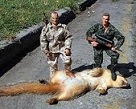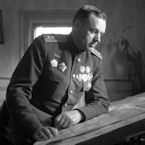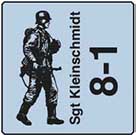Captain
Posts: 78
Joined: 5/1/2006
Status: offline

|
interesting discussion. I will wait until I have had a chance to play 1.05 before reaching a conclusion.
On another point, since this issue keeps coming up, the German Army had pleny of winter clothing/gear in december 41, all of it safely stored in warehouses, the problem was getting it to the front:
quote:
The severe winter weather was the third major reason that caused German defenders to adopt village-based strongpoints. Even by Russian standards, the 1941-42 winter was particularly harsh. From December until early March, military operations were hampered by heavy snowfall and by the few hours of winter daylight. Yet the extreme cold was by far the most significant aspect of the winter weather. During the winter battles, German and Russian forces clashed in temperatures routinely ranging from -I0°C to -30°C, with brief cold spells exceeding -40°C.47 Contrary to German belief, the cold was an impartial adversary that dogged the operations of both sides with equal intensity. However, the Germans were generally more vulnerable to the debilitating effects of the subzero temperatures due to a near-total lack of winter clothing and equipment.
Hitler blamed the Army High Command for the failure to provide winter necessities, ignoring any intimation that, he might bear some blame for the German military predicament. In a clever propaganda stroke, Nazi Party functionaries launched a massive emergency drive in late December to collect winter clothing from the German public. Direct action by the party and the people, it was implied, would rapidly correct the scandalous frontline conditions wrought by General Staff bungling.48 Coming at a time when Hitler was relieving "incompetent" and "disloyal" officers left and right, this program confirmed the popular impression that Adolf Hitler's personal intervention into the German Army's affairs was not only warranted but even overdue. So persuasive was this logic--and so thorough the propaganda effort to sell it--that even some high-ranking German military officers remained convinced after the war that slipshod General Staff planning had produced the shortage of winter equipment.49
However, the truth was far different, German soldiers fought without winter clothing or special equipment simply because the German supply system could not transport the items forward from rear depots. Normal winter-issue items (woolen vests, caps, earmuffs, scarves, and sweaters) were stocked in Germany and Poland, and General Halder had repeatedly discussed the need to provide these and other essentials to the fighting forces before the onset of winter. On 10 November, however, Halder learned that transportation difficulties would delay deliveries of winter clothing to the front until late January 1942 or even later.50
The German logistical system, already tottering from the strain of providing fuel, food, and ammunition to three army groups over the primitive Russian transportation net, was brought to the brink of total collapse by the arrival of winter. Sporadic partisan activity and an epidemic of locomotive breakdowns greatly curtailed German rail-haul capacity. (For instance, the number of German supply trains to the Eastern Front totaled only 1,420 in January 1942, compared to 2,093 in September 1941.)51 Losses of motor vehicles and draft horses further snarled supply distribution, and frantic attempts to press Russian pony-drawn panje wagons into service provided little immediate relief. Moreover, the severe cold increased the consumption rate of certain commodities. For example, German soldiers used large quantities of grenades and explosives to fracture the frozen earth in order to create makeshift foxholes. Likewise, fuel consumption did not decline in proportion to vehicle losses since drivers idled their motors round-the-clock to prevent engine freeze-up.52
Because the supply lines could not handle all the supplies that the Germans needed, the limited transportation space was devoted to such vital cargoes as ammunition and medical supplies. Since winter clothing is inherently bulky and therefore relatively inefficient to transport, it remained, for the most part, crated in warehouses in Poland and Germany, awaiting a lull in the logistical crisis when it could be shuttled forward without displacing other commodities.53 In the meantime, German soldiers had to fend for themselves as best they could.54
http://www.cgsc.edu/carl/resources/csi/wray/wray.asp#orgin
_____________________________
|
 Printable Version
Printable Version






















 We seem to bring out the passion in wargamers (at least the grognards), and will hopefully continue to do so.
We seem to bring out the passion in wargamers (at least the grognards), and will hopefully continue to do so.  New Messages
New Messages No New Messages
No New Messages Hot Topic w/ New Messages
Hot Topic w/ New Messages Hot Topic w/o New Messages
Hot Topic w/o New Messages Locked w/ New Messages
Locked w/ New Messages Locked w/o New Messages
Locked w/o New Messages Post New Thread
Post New Thread